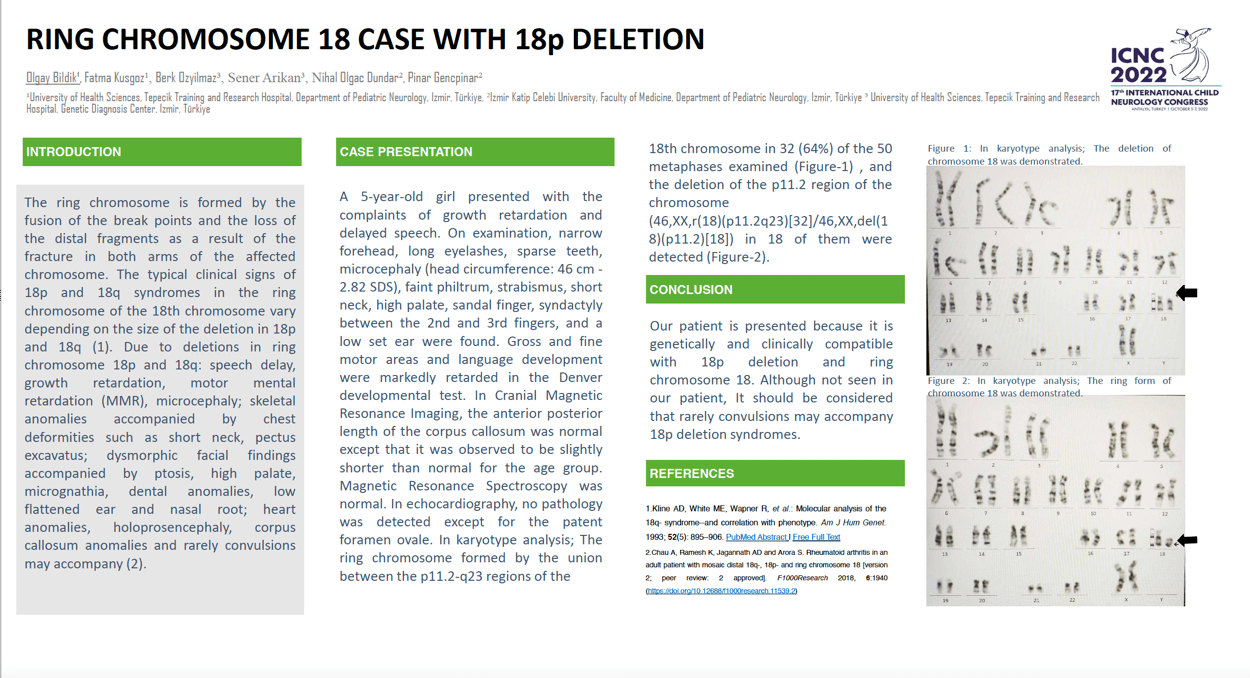Ring Chromosome 18 Case With 18p Deletion
OLGAY BILDIK, FATMA KUSGOZ, BERK ÖZYILMAZ, SENER ARIKAN, NIHAL OLGAC DUNDAR, PINAR GENCPINAR
INTRODUCTION The ring chromosome is formed by the fusion of the break points and the loss of the distal fragments as a result of the fracture in both arms of the affected chromosome. Due to deletions in ring chromosome 18p and 18q: speech delay, growth retardation, motor mental retardation (MMR), microcephaly, skeletal anomalies accompanied by chest deformities , dysmorphic facial findings, heart anomalies, holoprosencephaly, corpus callosum anomalies and rarely convulsions may accompany.
CASE: A 5-year-old girl presented with the complaints of growth retardation and delayed speech. On examination, narrow forehead, long eyelashes, sparse teeth, microcephaly, faint philtrum, strabismus, short neck, high palate, sandal finger, syndactyly and a low set ear were found. Gross and fine motor areas and language development were markedly retarded in the Denver developmental test. In Cranial Magnetic Resonance Imaging, the anterior posterior length of the corpus callosum was normal except that it was observed to be slightly shorter than normal for the age group. Magnetic Resonance Spectroscopy was normal. In karyotype analysis; The ring chromosome formed by the union between the p11.2-q23 regions of the 18th chromosome in 32 (64%) of the 50 metaphases examined, and the deletion of the p11.2 region of the chromosome (46,XX,r(18)(p11.2q23)[32]/ 46,XX,del(18)(p11.2)[18]) in 18 of them were detected.
DISCUSSION Our patient is presented because it is genetically and clinically compatible with 18p deletion and ring chromosome 18. It should be considered that rarely convulsions may accompany 18p deletion syndromes.
Keywords: ring chromosome 18, deletion
OLGAY BILDIK
University of Health Sciences, Tepecik Training and Research Hospital
Turkey
FATMA KUSGOZ
University of Health Sciences, Tepecik Training and Research Hospital
Turkey
BERK ÖZYILMAZ
University of Health Sciences, Tepecik Training and Research Hospital
Turkey
SENER ARIKAN
University of Health Sciences, Tepecik Training and Research Hospital
Turkey
NIHAL OLGAC DUNDAR
Izmir Katip Celebi University Medical Faculty
Turkey
PINAR GENCPINAR
Izmir Katip Celebi University Medical Faculty
Turkey
INTRODUCTION The ring chromosome is formed by the fusion of the break points and the loss of the distal fragments as a result of the fracture in both arms of the affected chromosome. Due to deletions in ring chromosome 18p and 18q: speech delay, growth retardation, motor mental retardation (MMR), microcephaly, skeletal anomalies accompanied by chest deformities , dysmorphic facial findings, heart anomalies, holoprosencephaly, corpus callosum anomalies and rarely convulsions may accompany.
CASE: A 5-year-old girl presented with the complaints of growth retardation and delayed speech. On examination, narrow forehead, long eyelashes, sparse teeth, microcephaly, faint philtrum, strabismus, short neck, high palate, sandal finger, syndactyly and a low set ear were found. Gross and fine motor areas and language development were markedly retarded in the Denver developmental test. In Cranial Magnetic Resonance Imaging, the anterior posterior length of the corpus callosum was normal except that it was observed to be slightly shorter than normal for the age group. Magnetic Resonance Spectroscopy was normal. In karyotype analysis; The ring chromosome formed by the union between the p11.2-q23 regions of the 18th chromosome in 32 (64%) of the 50 metaphases examined, and the deletion of the p11.2 region of the chromosome (46,XX,r(18)(p11.2q23)[32]/ 46,XX,del(18)(p11.2)[18]) in 18 of them were detected.
DISCUSSION Our patient is presented because it is genetically and clinically compatible with 18p deletion and ring chromosome 18. It should be considered that rarely convulsions may accompany 18p deletion syndromes.
Keywords: ring chromosome 18, deletion
OLGAY BILDIK
University of Health Sciences, Tepecik Training and Research Hospital
Turkey
FATMA KUSGOZ
University of Health Sciences, Tepecik Training and Research Hospital
Turkey
BERK ÖZYILMAZ
University of Health Sciences, Tepecik Training and Research Hospital
Turkey
SENER ARIKAN
University of Health Sciences, Tepecik Training and Research Hospital
Turkey
NIHAL OLGAC DUNDAR
Izmir Katip Celebi University Medical Faculty
Turkey
PINAR GENCPINAR
Izmir Katip Celebi University Medical Faculty
Turkey

OLGAY BILDIK
University of Health Sciences, Tepecik Training and Research Hospital Turkey
University of Health Sciences, Tepecik Training and Research Hospital Turkey